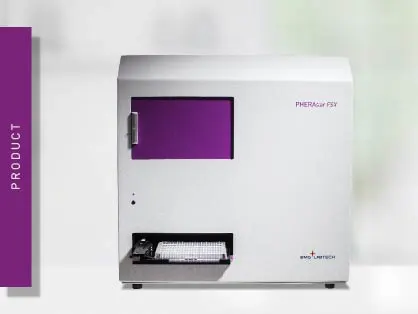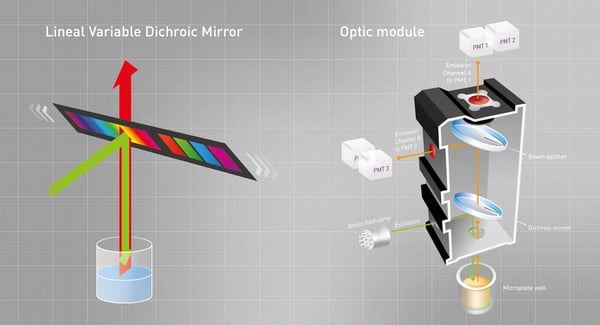
PHERAstar FSX
Powerful and most sensitive HTS plate reader
If you’ve used a microscope or a filter-based plate reader you’ve probably heard the term “dichroic” at some point. And if you’ve read the term “dichroic mirror” maybe you’ve always wondered what kinds of other words might follow that term in a sentence but have never made it that far. If you’ve made it this far, you might be thinking to yourself, “why am I bored right now?” but can’t quite put your finger on it. Let’s soldier on to see if we can find out.
Mirrors reflect light (duh.) But there are dozens of types of mirrors. In LCD projectors, mirrors may be designed to reflect some photons toward the viewer and others away, creating a display of different colors or contrast levels. Perhaps just to the right of this post, you are seeing a banner ad featuring an unsightly paunch with text telling you how you can lose 18 pounds in only two weeks? Depending upon your display, a mirror may be forcing you to see that.
But mirrors can do more than just ruin your internet browsing experience! A 50/50 mirror, or a beam splitter, can reflect half of the incoming light it receives and let the other half pass through. This is useful if you want to send a little light in two directions. It is not that useful if your purpose is damaged by having 75% of your useable light-headed in the wrong direction. With optical engineering, we can create mirrors that preferentially reflect some wavelengths and, as you might imagine, this has countless uses. Dichroic and dielectric mirrors that can do that are why we entertain our cats with laser light or produce telescopes that only operate in the infrared. And they have important roles to play in detection equipment.
In our PHERAstar FSX, we use optic modules that contain dichroic mirrors. They reflect low wavelength excitation light down to the sample, but let longer wavelength emission light pass through to the detector. Like so:

Typically, monochromator-based plate readers do not use dichroic mirrors at all. The benefit of a monochromator is that it can be conveniently tuned to any wished wavelength. If you had to buy and insert a dichroic mirror each time you wished to tune to a new fluorescence wavelength, that would certainly improve performance, but almost all of the flexibility advantages of a monochromator would be gone. Flexibility however comes with big performance sacrifices.
BMG LABTECH included a linear variable dichroic mirror (LVDM) in its CLARIOstar Plus and VANTAstar monochromator-based reader. This provides the performance of a filter-based instrument while still allowing users to tune to any wavelength. It is one of the reasons why the CLARIOstar Plus performs much better than any other monochromator-based reader. The LVDM slide is positioned between excitation and emission monochromators and can block or transmit different ranges of wavelength throughout its length.
A tunable dichroic mirror means that the CLARIOstar Plus and VANTAstar monochromator can use direct excitation optics, just like a filter-based reader. The low background and efficient light transmission would not be possible without these mirrors.
Powerful and most sensitive HTS plate reader
Most flexible Plate Reader for Assay Development
Flexible microplate reader with simplified workflows
Absorbance plate reader with cuvette port